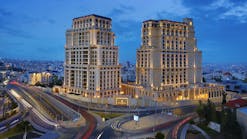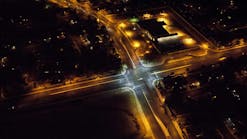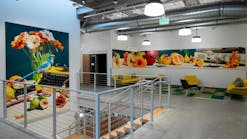What now is an elegant display of light was once a spectacle of burned out incandescent bulbs that marred the hotel's otherwise glittering image. Frustrated by the plague of burned out lights, the Hyatt Regency enlisted George Abramson, owner of GAR Energy Management Group, to find a reliable, energy-efficient light source. Of course, he chose LEDs. "Nothing else could do the job as well," says Abramson. "LEDs have extremely long operating lives, they're low wattage and they're exceptionally energy efficient."
While bright and highly visible, the incandescent lamps that formerly shaped the contour of the sail burned out quickly. Due to their positions high on the side of the building, replacing failed lamps was difficult and was carried out only three times a year when a window-washing scaffold provided access.
Cool white choice
Abramson decided on a seven-LED S6 candelabra-screw based lamp (part number SF467-0CW-120A) from LEDtronics, based upon its brightness and direct incandescent replacement design. The LED bulb would fit into the light fixtures without requiring any modifications, saving the Hyatt Regency the expense of purchasing new fixtures and the subsequent cost of installation. The lamps are installed into light fixtures that have four candelabra sockets clustered together so that from a distance the four lights appear as one.
Cool white (8000 K) LED lamps were chosen for the project because their intense white light stood out amongst the abundant ambient light. The lamps emit 742 mcd of cool-white light at a wide viewing angle (120°) while drawing only 10 mA. What also appealed to the Hyatt Regency was the LED lamp's sealed construction and shape. While the impervious exterior of the lamp safeguards the circuitry and LEDs from the elements, its tapered shape allowed the addition of a water-resistant gasket that snugs against the light fixture's o-ring to prevent corrosive sea air from harming the lamp's base and fixture's socket.
Energy conservation
Calculations suggested that the Hyatt Regency would see a return on their investment within 2.2 years due to the energy and labor dividends gained from using LEDs. LEDs typically consume 90% less energy than incandescent lights. In the sail application, the 472 lamps are on for about 12 hours each night (an annual total 4,380 hours). The incandescent lamps drew 7W each at $0.09 kWh, amounting to an annual power expense of $1302.44. The retrofit LED lamps draw 0.08W each for an annual electricity cost of about $14.88, an annual saving of $1287.56 a year, or nearly $3862.68 over the three-year warranty period of the lamps. The annual energy saved is 14,306 kWh.
Cost savings multiply when parts, maintenance and labor are considered, especially since an average incandescent bulb operates for about 1000 hours.
Burned out incandescent lamps, maintenance difficulties and image concerns compelled the Hyatt Regency to find a better source of illumination for the sail wall. Since the LEDtronics LED lamps were installed in April 2003, the hotel has benefited from the drastic reductions in the power, maintenance and labor costs associated with operating the sail. Most importantly, since all 472 LED lamps still work, the Hyatt Regency is enjoying smooth sailing.






